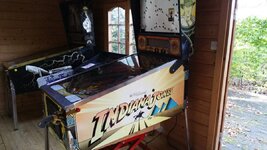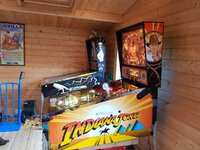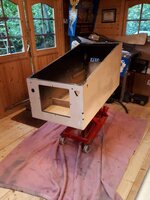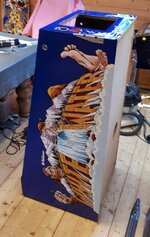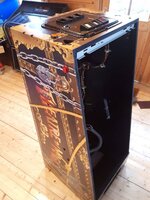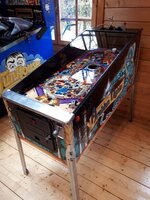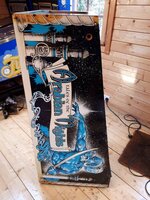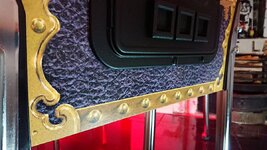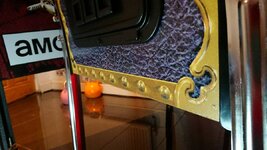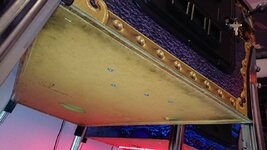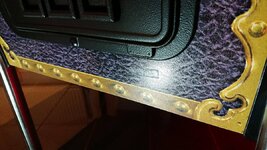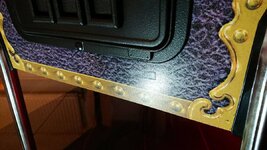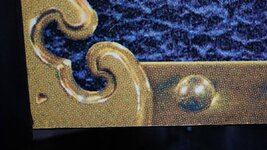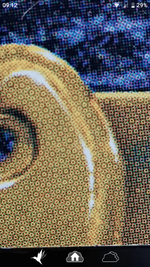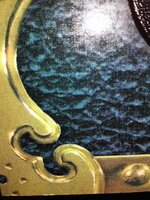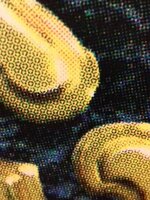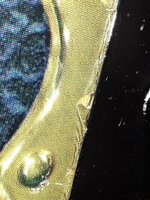I have had several machines professionally re-decalled and the results are amazing. If getting it done always use the best quality decals available usually from Planetary Pinball. The results are as good as it rolling of the factory if done right, but have also seen a few done really badly. All depends on the workmanship.
Pinball info
You are using an out of date browser. It may not display this or other websites correctly.
You should upgrade or use an alternative browser.
You should upgrade or use an alternative browser.
How to tell if original decals or not?
- Thread starter Rob zombie
- Start date
The Next Generation from PPS are silkscreened.Tell me what to check forIf I rub my hand along the cabinet there is a very obvious texture. Identical to an original RFM I owned, which I believe was screen printed(?)
https://www.ministryofpinball.com/en/theatre-of-magic-cabinet-decals.html
As I said, if you take a picture where surface is visible with some light reflections, I might be able to tell.Theatre Of Magic Silkscreened Cabinet Artwork Decals - 5 Pieces includes Door, Left Side, Right Side, Left Backbox, Right Backbox. Made from original WMS artwork- Next Generation .
Your machine is re-decal-ed. Just think about it. How on earth would it stay like this for 25 years unless you just unboxed it. The only question is where did the decals come from. If the restorer did a good job, he/she bought them from PPS. The underside of your cabinet shows wear, yet somehow the decals are perfect...
Can I just clarify that all original B/W cabs ( except for later machines such as MB & CC) were silkscreen printed onto the cabinet and not onto a separate decal that was applied to the cabinet. Or am I mistaken? If it’s a seperately applied decal ( no matter how it’s printed) its a result of a refurbishment.
If this is not the case can someone confirm, as if not I’m confused.
Even the Sterns such as Tron, Avatar ( both of which I have, 1 decal and one screen printed onto cab) have both versions through there release.
@Moonraker has confused me even more as I would have thought he would have as good an idea as anyone?
Cheers
If this is not the case can someone confirm, as if not I’m confused.
Even the Sterns such as Tron, Avatar ( both of which I have, 1 decal and one screen printed onto cab) have both versions through there release.
@Moonraker has confused me even more as I would have thought he would have as good an idea as anyone?
Cheers
@Rob zombie yours look like originals.
My Toms has originals and a pretty rough texture on the surface .
Sticker in the same area as yours.
My Toms has originals and a pretty rough texture on the surface .
Sticker in the same area as yours.
See I’m not convinced it’s looks pixcelised which screen printed wouldn’t be
Its a strange pattern. Not exactly pixelated, more like hexagons. I'll try to get a better pic tomorrow. I remember when I came to take pictures of my RFM it looked like crap with the flash on. Really pixelated.See I’m not convinced it’s looks pixcelised which screen printed wouldn’t be
Original or not I dont think it matters aslong as it looks good
? I’m sorry but agree with Rudedog, and as clarified earlier. If it’s a seperately applied decal it’s a refurb. If the artwork is screen printed directly onto the cabinet it’s original.@Rob zombie yours look like originals.
My Toms has originals and a pretty rough texture on the surface .
Sticker in the same area as yours.
All the pictures show it’s a decal applied to the cab. If it’s got texture then it’s just a very good copy.
I’m sure Chris B, or someone else with loads of experience/history will be able to clarify
? I’m sorry but agree with Rudedog, and as clarified earlier. If it’s a seperately applied decal it’s a refurb. If the artwork is screen printed directly onto the cabinet it’s original.
All the pictures show it’s a decal applied to the cab. If it’s got texture then it’s just a very good copy.
I’m sure Chris B, or someone else with loads of experience/history will be able to clarify
Would be good if an expert could chime in for sure. Logic does certainly suggest it must be decals. BUT.......why would a re-decal job have sticky residue marks where the rectangle stickers should be? That doesn't make any sense.
I redecalled a really faded DW and I had to use a heat gun to take off the old decals. Thinkinit was 1992 release. I've seen that also with IJ (93) but my JD same year was printed on the cab but RS from that same year was decals as had wrinkles around the legs. I'm not sure there was any consistency back in the day unless several pins I've owned have been redone and I don't think that's the case.
I think only a few
I know that first run of pins maybe screen printed direct onto cab but further into production they used decals.
See I’m not convinced it’s looks pixcelised which screen printed wouldn’t be
I know that first run of pins maybe screen printed direct onto cab but further into production they used decals.
BUT.......why would a re-decal job have sticky residue marks where the rectangle stickers should be? That doesn't make any sense.
if they are licensed decals..
That was a good read and clarified several of the questions above. Interesting to see why some of the B/W cabs faded badly.
My TAF is screen printed directly onto cab but that’s the only one I’ve seen like that.
Dots. Screen printed
So I guess the hexagonal pattern is the shape of the mesh the ink is pushed through?
Cool  Thanks! It's certainly turned out to be a much more complicated subject than I was expecting. But yes, original then it seems safe to say.
Thanks! It's certainly turned out to be a much more complicated subject than I was expecting. But yes, original then it seems safe to say.
https://pinballdecals.eu/shop/theatre-of-magic-pinball-cabinet-decals-set/
https://www.ministryofpinball.com/en/theatre-of-magic-cabinet-decals.html
https://www.bestofpinball.com/catalog/index.php?main_page=product_info&cPath=0&products_id=4795
I am still going to say that your cabinet was re-decaled There's one more opiton as well: NOS Decals.
There's one more opiton as well: NOS Decals.
https://www.ministryofpinball.com/en/theatre-of-magic-cabinet-decals.html
https://www.bestofpinball.com/catalog/index.php?main_page=product_info&cPath=0&products_id=4795
I am still going to say that your cabinet was re-decaled
https://pinballdecals.eu/shop/theatre-of-magic-pinball-cabinet-decals-set/
https://www.ministryofpinball.com/en/theatre-of-magic-cabinet-decals.html
https://www.bestofpinball.com/catalog/index.php?main_page=product_info&cPath=0&products_id=4795
I am still going to say that your cabinet was re-decaledThere's one more opiton as well: NOS Decals.
It looks great but I’m no real expert except having 4 Manny cabs and good ones to add.
and good ones to add.
https://pinballdecals.eu/shop/theatre-of-magic-pinball-cabinet-decals-set/
https://www.ministryofpinball.com/en/theatre-of-magic-cabinet-decals.html
https://www.bestofpinball.com/catalog/index.php?main_page=product_info&cPath=0&products_id=4795
I am still going to say that your cabinet was re-decaledThere's one more opiton as well: NOS Decals.
Wait....hold all those horses! Those decals wouldn't have the rectangle stickers though would they?
https://pinballdecals.eu/shop/theatre-of-magic-pinball-cabinet-decals-set/
https://www.ministryofpinball.com/en/theatre-of-magic-cabinet-decals.html
https://www.bestofpinball.com/catalog/index.php?main_page=product_info&cPath=0&products_id=4795
I am still going to say that your cabinet was re-decaledThere's one more opiton as well: NOS Decals.
Not sure why showing links to site selling decals explains what @Rob zombie cabinet has?
The images I've seen on other pinball cabinets shown here shows the same pattern and texture.
Mine is exactly the same and has a texture produced by silk screening dithering i'm pretty sure is orignal.
As explained on that website I linked earlier some early cabs were printed directly onto a white painted wood.
The remainder printed onto wood that had white decal.
Just to clairify, the dot patterns you are all discussing are called CMYK Halftone. You will see them on both digitally printed items as well as silkscreened, but the only difference is resolution - Stern has (had rather) notoriously crappy resolution because the mesh size they used was very big, whereas Bally Williams games used a much smaller mesh size but you can still see the dot pattern when you look closely, and modern printers are able to cram obscene amounts of dots into a square inch.
The CMYK (Cyan, Magenta, Yellow and Key - meaning black) process is simply 4 different coloured inks stacked on top of each other at different angles. Like so:

Depending on how far away you are, you will see hexagonal patterns start to form and then going further back eventually you see the full image clearly:
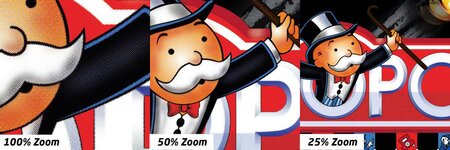
The above image is from the Monopoly decals I restored for Retro Refurbs, they were completely drawn from scratch and the CMYK Halftone pattern had to be manually created. This is then digitally printed.
But even screen printed stuff made in the 90's was able to get very fine dot mesh, like this Roadshow translite which shows the same dot pattern:
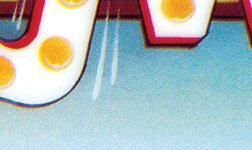
Regardless, whether decals are printed digitally or by screen it makes no difference as both can achieve the same effect. It's hard to say if that ToM has been redecalled or original without inspecting it closely, but either way who really cares? If the game looks nice and plays well then just enjoy some pinball... and beer!
The CMYK (Cyan, Magenta, Yellow and Key - meaning black) process is simply 4 different coloured inks stacked on top of each other at different angles. Like so:

Depending on how far away you are, you will see hexagonal patterns start to form and then going further back eventually you see the full image clearly:

The above image is from the Monopoly decals I restored for Retro Refurbs, they were completely drawn from scratch and the CMYK Halftone pattern had to be manually created. This is then digitally printed.
But even screen printed stuff made in the 90's was able to get very fine dot mesh, like this Roadshow translite which shows the same dot pattern:

Regardless, whether decals are printed digitally or by screen it makes no difference as both can achieve the same effect. It's hard to say if that ToM has been redecalled or original without inspecting it closely, but either way who really cares? If the game looks nice and plays well then just enjoy some pinball... and beer!
Last edited:

